Frontiers of Image Reconstruction
Oral
Acquisition, Reconstruction & Analysis
Monday, 18 June 2018
| N03 |
16:15 - 18:15 |
Moderators: Julia Velikina, Sajan Goud Lingala |
16:15
 |
0242.
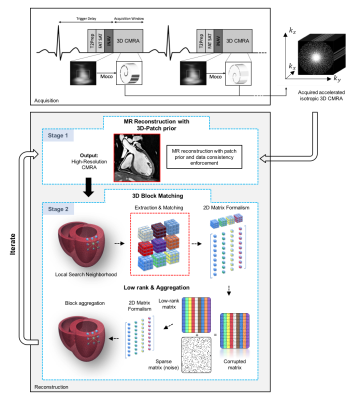 |
 3D-Patch-Based Low-Rank Reconstruction (PROST) for Highly-Accelerated CMRA Acquisition 3D-Patch-Based Low-Rank Reconstruction (PROST) for Highly-Accelerated CMRA Acquisition
Aurelien Bustin, Gastao Cruz, Giulia Ginami, Teresa Correia, Imran Rashid, Radhouene Neji, Rene Botnar, Claudia Prieto
Free-breathing coronary MR angiography (CMRA) has shown great potential to visualize coronary stenosis. Three-dimensional (3D) CMRA, however, remains time consuming because a large amount of data is needed to accurately visualize all major coronary arteries. Scan acceleration using compressed sensing (CS) reconstruction has successfully been applied to coronary artery imaging. For high acceleration factors, however, CS-based techniques suffer from residual aliasing artifacts which compromise the diagnostic value of the reconstructed image. We propose a new 3D-patch-based reconstruction that exploits the complex 3D anatomy of the coronary arteries in an effective low-rank framework, which combined with 100% respiratory efficiency enables high-quality isotropic Cartesian CMRA images in ~3 mins.
|
16:27
|
0243.
 |
 Kernel low-rank regularization: an efficient approach for recovering dynamic images on a manifold Kernel low-rank regularization: an efficient approach for recovering dynamic images on a manifold
Sunrita Poddar, Yasir Mohsin, Bijoy Thattaliyath, Diedra Ansah, Mathews Jacob
The main focus of this abstract is to introduce an efficient algorithm to recover a free breathing and ungated cardiac MR image series from highly undersampled measurements. The main contributions are (i) a kernel low-rank algorithm to estimate the manifold structure (Laplacian) from noisy navigator signals, (ii) a fast algorithm that uses the Laplacian basis functions to recover the data from highly undersampled measurements. The utility of the algorithm is demonstrated on radial acquisitions from patients with congenital heart disease; the results show that the framework is a promising alternative to self-gating methods.
|
16:39
|
0244.
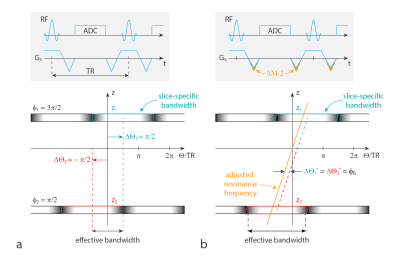 |
 Gradient-Controlled Local Larmor Adjustment (GC-LOLA) for CAIPIRINHA-Accelerated bSSFP Imaging with Improved Banding Behavior Gradient-Controlled Local Larmor Adjustment (GC-LOLA) for CAIPIRINHA-Accelerated bSSFP Imaging with Improved Banding Behavior
Daniel Stäb, Peter Speier
The simultaneous multi-slice (SMS) imaging technique CAIPIRINHA has proven to be highly efficient for extending the slice coverage in 2D imaging. When accelerating balanced steady-state free-precession (bSSFP) sequences with SMS-CAIPIRINHA, modulating k-space by means of slice-specific RF phase cycles leads to undesired slice-specific shifts of the bSSFP pass-band structure. Gradient-controlled local Larmor adjustment (GC-LOLA) removes this drawback. By means of slice gradient unbalancing, the Larmor frequency is made slice position dependent, which allows compensating for the pass-band shifts and stabilizes CAIPIRINHA-accelerated bSSFP imaging with respect to B0 field inhomogeneity.
|
16:51
|
0245.
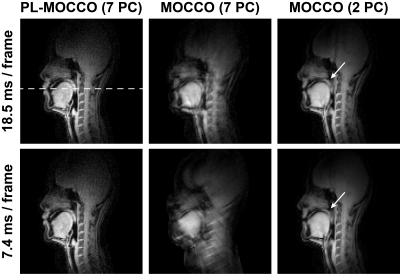 |
 Ultrafast Speech Imaging at High Spatial Resolution using Model-Consistency Condition Reconstruction with Progressive Temporal Basis Learning Ultrafast Speech Imaging at High Spatial Resolution using Model-Consistency Condition Reconstruction with Progressive Temporal Basis Learning
Julia Velikina, Andrew Alexander, Joseph Salmons, Eric Raimy, Thomas Purnell, Steven Kecskemeti, Alexey Samsonov
Dynamic MRI holds high potential for real-time imaging of upper airway, which can provide insights into questions of speech science and also have important clinical applications. However, speech imaging places increased demands on spatial and temporal resolution, necessitating image reconstruction from severely undersampled data. Previously reported methods use low-rank constraints with spiral navigators to enable temporal basis estimation, otherwise infeasible with standard learning methods. We propose an alternative solution based on a novel concept of progressive learning, which does not require separate specialized pulse sequences for navigator acquisitions, while providing high 7.4 ms temporal and 1.25x1.25x8 mm spatial resolution.
|
17:03
 |
0246.
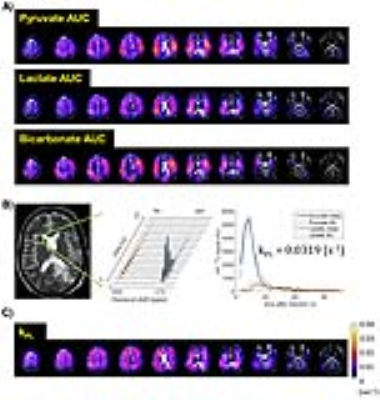 |
 3D Dynamic Hyperpolarized-13C Parallel MRI of Human Brain using SVD Low-Rank Matrix Completion 3D Dynamic Hyperpolarized-13C Parallel MRI of Human Brain using SVD Low-Rank Matrix Completion
Hsin-Yu Chen, Ilwoo Park, Peng Cao, Robert Bok, Jeremy Gordon, Peter Shin, James Slater, Mark van Criekinge, Lucas Carvajal, Adam Autry, John Kurhanewicz, Peder Larson, Daniel Vigneron
The goal of this feasibility study was to develop and apply new 3D dynamic hyperpolarized 13C combined parallel imaging + compressed sensing MRI methods for human brain studies. The new framework utilizing multichannel coils and low-rank matrix completion reconstruction provided greatly improved coverage as compared to prior 2D acquisitions. Whole-brain coverage was achieved, while maintaining the image quality in terms of spatial distribution, temporal dynamics and quantitative accuracy of the 13C biomarkers. Animal studies and simulations also showed that the pMRI+CS framework provided improved performance over CS alone, and was able better to recover low-SNR peaks.
|
17:15
 |
0247.
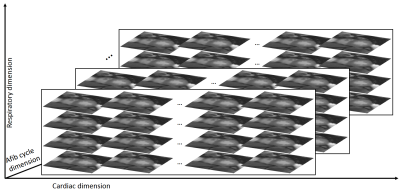 |
 Reconstruction of Arrhythmic Cardiac Cycles in Patients with Atrial Fibrillation Reconstruction of Arrhythmic Cardiac Cycles in Patients with Atrial Fibrillation
Teodora Chitiboi, Li Feng, Rebecca Ramb, Ricardo Otazo, Leon Axel
Arrhythmia is often a significant challenge to acquiring diagnostic quality cardiac MRI. While discarding atypical cardiac cycles can exclude short-lived arrhythmic events, such as premature ventricular contractions (PVCs), this fails for atrial fibrillation (Afib), where subjects have an irregular cardiac cycle pattern. Harnessing the potential of the XD-GRASP MRI technique to reconstruct continuously acquired data with cardiac and respiratory phase as extra dimensions, we propose to additionally classify cardiac cycles for Afib patients according to their preload state, and simultaneously reconstruct the different types of arrhythmic cycles in a five-dimensional image space.
|
17:27
|
0248.
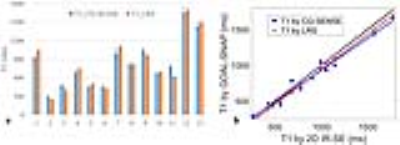 |
 Highly Undersampled Kooshball Reconstruction with Low-rank Modeling and Sparsity Constraints for High-resolution T1 Mapping Highly Undersampled Kooshball Reconstruction with Low-rank Modeling and Sparsity Constraints for High-resolution T1 Mapping
Haikun Qi, Huiyu Qiao, Aiqi Sun, Shuo Chen, Xihai Zhao, Rui Li, Chun Yuan, Huijun Chen
Highly undersampled 3D radial is very useful for 3D imaging acceleration, and compressed sensing and low-rank can be used for reconstruction of the undersampled kooshball data. In this study, we propose a novel reconstruction method for fast 3D T1 mapping of carotid artery using 3D radial sampling. The reconstruction method is based on low-rank modeling with parallel imaging and sparsity constraints, and is potential to improve the accuracy and precision of T1 estimation. The aim of this study is to evaluate the effectiveness of the proposed method using phantom and in vivo imaging experiments on volunteers and carotid atherosclerosis patients.
|
17:39
|
0249.
 |
 Assessing MR image reconstruction quality using the Fourier Radial Error Spectrum plot Assessing MR image reconstruction quality using the Fourier Radial Error Spectrum plot
Tae Hyung Kim, Justin Haldar
This work introduces the Fourier radial error spectrum plot (ESP) as a novel approach to quantifying the quality of reconstructed MR images. While conventional error metrics such as normalized root mean squared error (NRMSE) or structural similarity (SSIM) are widely used, they are simple scalar-measures that only provide one-dimensional insight into image quality. In contrast, ESP describes reconstruction quality with a spectrum that provides a quantitative evaluation of image quality at every spatial resolution scale. Our results show that ESP provides more comprehensive information than conventional error metrics, and can guide the design of new and improved image reconstruction approaches.
|
17:51
 |
0250.
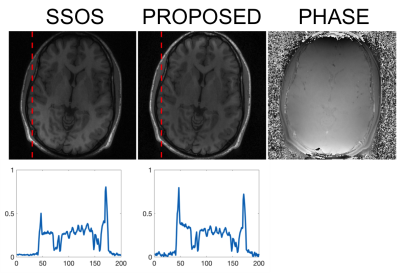 |
 Complex Image Extraction in Phased-Array Imaging Complex Image Extraction in Phased-Array Imaging
Peter Shin, Daniel Vigneron
Phased-array coils are used in MRI to improve signal-to-noise ratio (SNR) or to accelerate data acquisition speed through parallel imaging. It is beneficial to have a phased-array imagery reconstruction method that extracts the complex magnetization information from the multichannel data. In this work, we adopt the fusion frame theory to estimate the magnitude of the underlying magnetization and further employ the matched-filter method to estimate the magnetization phase, thereby reconstructing a complex image that does not have coil sensitivity weightings.
|
18:03
|
0251.
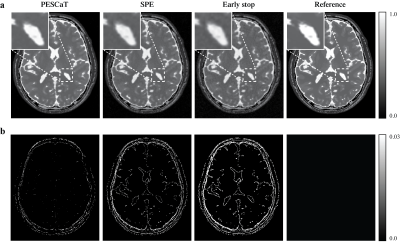 |
 Rapid self-tuning compressed-sensing MRI using projection onto epigraph sets Rapid self-tuning compressed-sensing MRI using projection onto epigraph sets
Mohammad Shahdloo, Efe Ilicak, Mohammad Tofighi, Emine U. Saritas, A. Enis Cetin, Tolga Çukur
Successful compressed-sensing reconstruction often involves tuning one or more regularization weights. However, tuning the regularization weights is a subject-specific, task-dependent and non-trivial task. Recent studies have proposed to determine the weights by minimizing the statistical risk of removing significant coefficients using line searches across a range of parameters. However, the line-search procedures lead to prolonged reconstruction times. Here, we propose a new self-tuning approach generalized for multi-coil, multi-acquisition CS reconstructions that leverage projection onto epigraph sets of l1 and TV balls. The proposed method yields 7 to 9-fold gain in computational efficiency over conventional methods while enabling further improved image quality.
|
|













